If there is an unfilled area in your garden, it doesn’t matter whether it’s a flowerbed, a place on an alpine hill or under a tree, or maybe just an empty container, plant astilbe there and you won’t regret it at all. Now we'll tell you why.
| Content:
|

This is what astilbe looks like in the garden.
Astilbe flower - description and varieties of plant
Astilbe came to Russia from East Asia or Japan and adapted to our climate so much that it learned to tolerate severe frosts in winter and high temperatures in summer. The only thing this plant could not refuse was the presence of moisture in the same amount as in its natural habitat (shady forest or stream bank).
Astilbe is a herbaceous perennial that forms a powerful, beautiful, sometimes multi-colored clump that dies off in the winter and grows again in the spring from its rhizomes.
The height of the plant varies - from 15 cm to 2 m. The basal leaves have a beautiful carved shape and are red-green or dark green.
The inflorescences are located on a high stem, have a fluffy texture and various shapes: rhombus, panicle, pyramid or downward, drooping branches.
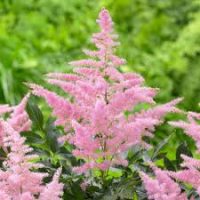 Diamond inflorescence |
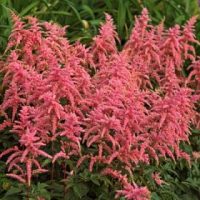 Inflorescence panicle |
 Inflorescence pyramid |
Flowering in all varieties of astilbe lasts approximately 1 month, but at different times:
- early bloomers bloom in June,
- medium flowering - in July,
- late - in August.
Previously, these flowers were only white, pink-lilac or purple. Now there is such a variety of colors and shades in the assortment that it is simply impossible not to be interested in astilbe and it is definitely worth growing it in open ground, especially since it is easy and pleasant to do.
The ease and pleasantness lies in the fact that the plant reproduces well, rarely gets sick and is almost not affected by pests.
Where is the best place to plant astilbe?
When choosing a place to plant astilbe, you need to consider three factors:
-
- The plant can live in one place for up to 15 – 20 years.
- It is growing quickly.
- In sunny places the flowering period is shorter.
In regions with a cool climate and frequent rains, astilbe can be planted in open areas and alpine hills.
In hot places, astilbe plantings should be given partial shade. This is especially important for medium-flowering specimens, since their flowering period coincides with the highest temperatures.
Astilbe that blooms in June–July and August–September can be planted in the sun, since peak temperatures will not affect the duration of flowering of these species. But in this case you will have to pay special attention to watering it.
Astiba plantings along the edge of an artificial reservoir look extremely beautiful! In addition, plants will really like the proximity of water.
In any place it is necessary to prepare fertile light soil and provide sufficient watering and mulching.
Planting time depends on the chosen propagation method.
How to grow astilbe at home
Breeding astilbe is completely simple. It reproduces best vegetatively:
- dividing an adult bush into parts,
- renewal buds.
Growing astilbe from seeds is also possible, but it has one nuance that should be discussed separately. The problem is that specimens grown from collected seeds do not retain the qualities of the mother plants. Experience shows that the following changes are possible:
- difference in color, most often pale pink,
- loss of decorativeness (pomp) of the brush,
- shortening the flowering period.
There is no need to completely abandon this method of growing astilbe, but for this you need to use only selection seed material.
Growing astilbe from seeds
Sowing seeds
You can sow seeds either as seedlings or directly into the ground, the main thing to remember is that the seed material needs stratification.
- If you choose the method of sowing in the ground, it is better to do it in the fall. To do this, fence the prepared area with boards or flexible borders, distribute the seeds over the surface of the soil, lightly sprinkle with earth and cover with covering material. Over the winter, the process of stratification will take place, and the seeds will sprout vigorously.
- In apartment conditions, it will take 3 weeks to stratify the seeds. At this time, the seeds mixed with peat or sand and moistened are placed in the refrigerator at a temperature no higher than +4 - +6 degrees. Then, in early - mid-March, they are sown in containers for germination in warmth and light. Shoots appear in 2 – 3 weeks.
Seedling care
When 2–3 true leaves appear, the seedlings need to be picked into separate cups. Caring for astilbe at this time is very simple - timely watering and protection from direct sunlight.
Planting seedlings in the ground
Usually 2–3 months pass between sowing astilbe and planting it in open ground. The best time for planting is the onset of stable warm temperatures. The plant is not capricious, takes root well and grows quickly. Flowering occurs in the 2nd – 3rd year of life.
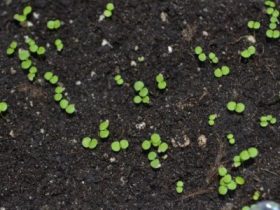 Astilbe seedlings |
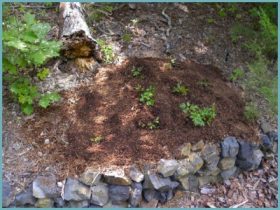 Transplanting |
Planting astilbe in the ground with rhizomes
Most often, astilbe is grown from rhizomes. Moreover, their sale begins long before the start of the planting season and ends quickly, since the plant is very popular. How to store rhizomes purchased in advance?
- If the rhizome is still dormant, you can store it in the refrigerator and plant it in open ground as soon as possible.
- If a sprout has already appeared, then you need to place it in a container with soil and place it in a bright but cool place.
- Sometimes such specimens still form peduncles in containers. You can leave them, since astilbe is a strong plant and can tolerate both replanting and flowering at the same time.
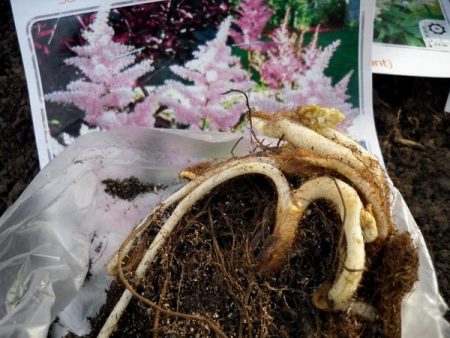
Awakened astilbe rhizome
Before planting, rhizomes purchased or stored in winter must be thoroughly inspected and dry or damaged parts removed. If the rhizome was very dry, then you need to wrap it in a napkin soaked in epin for 6 hours.
The planting hole is prepared taking into account the size of the rhizome, that is, for each individual: the main thing is that the roots are distributed evenly, the depth is sufficient, and the growing point is above the ground.
The soil should be fertile and light. One handful of bone meal and ash, 25–30 g of mineral fertilizers, humus are poured into the bottom of the pit, everything is mixed and filled with water. After this, the rhizome is placed there, buried and mulched with a layer of peat at least 3–5 cm thick.
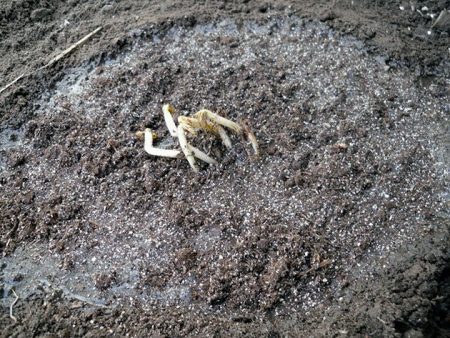
Planting rhizomes in the ground
The distance between plants depends on their variety and purpose of planting. For example, when creating a border from tall astilbes, a distance of 50 cm is maintained, but in any case, it should not be less than 30 cm.
How to care for astilbe in spring and summer
As mentioned above, the leaves and stems of astilbe die off in the winter and grow back in the spring. In order for the plant to quickly gain green mass, it is necessary to feed it in the spring with mineral fertilizers with a high nitrogen content.
During flowering, astilbe needs phosphorus fertilizing so that the brushes are lush and bloom for as long as possible.And closer to autumn, it’s time to apply potassium fertilizers to help the rhizomes prepare for winter.
The main care for astilbe during the warm period is regular watering, since the plant does not tolerate a lack of moisture. On particularly hot days, it is advisable to water even 2 times a day - in the morning and in the evening.
Periodic mulching will not only help retain moisture, but also protect against weeds, and also create a warm shelter for the rhizomes before winter. Before mulching, the soil must be loosened, then spread a layer of mulch and loosened again. It is better to repeat this procedure three times per season.
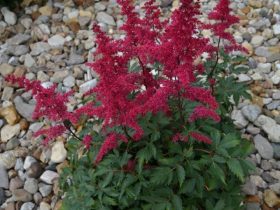 Mulching with pebbles |
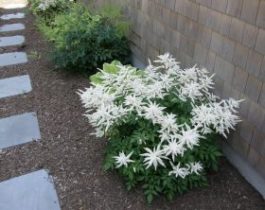 Mulching with wood chips |
Astilbe has one peculiarity - it seems to rise from the ground due to vertical growth. Because of this, young roots and buds are too close to the surface and can overheat or dry out. In this situation it is necessary adding fertile soil. In the spring, you also need to check the plantings and add bedding where it is required.
Astilbe transplant.
In open ground, astilbes multiply very quickly and they have to be periodically divided and replanted. Some varieties require this procedure every 3 to 4 years, but most require it every five years.
If the transplant is scheduled for spring, then you need to wait for stable warmth and the possibility of providing frequent watering. At any other time, even during the flowering period, transplants are successful, the main thing is to ensure abundant watering for two weeks after this.
Late-flowering astilbes, transplanted in March, bloom at their appointed time - in August - early September. So you can confidently undertake the transplant and be confident of success!
3 ways to propagate astilbe
There are three methods of propagating astilbe:
- Seeds
- By dividing the rhizome
- Kidney renewal
1 way. Propagation by seeds
As we already discussed, not the best way. The collected seeds are not suitable for sowing, as they do not retain their maternal qualities. Good selection planting material can only be purchased from the most reliable suppliers.
The process of growing astilbe from seeds is long and labor-intensive, because the seeds require stratification, seedlings require diving and care at home, as well as increased watering after planting in open ground, etc.
In addition, the plant blooms only in the third year. But the higher the reward!
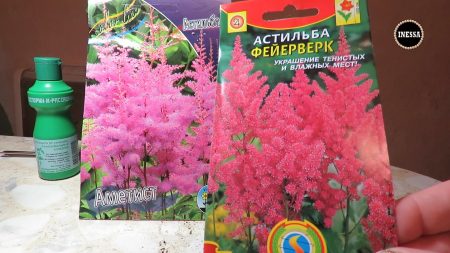
Propagation by seeds.
Method 2. Dividing the bush
This is a favorite method among gardeners, as it always gives good results. The best time for this is early spring, but provided there is sufficient moisture and warmth.
You can divide astilbe even during flowering. Purchasing cuttings with flowering clusters allows you to see all the features of the future bush and determine its flowering period. The survival rate of such plants is good if proper care is provided (ample watering, loosening, mulching).
The division procedure is as follows:
- The mother bush is carefully dug up.
- The rhizome is cut into pieces 3–5 cm long with 2–3 buds.
- The sections are sprinkled with wood ash and dried.
- Planting holes or furrows are prepared, fertile soil and fertilizers are added, and everything is watered.
- The divisions are placed at a distance of at least 30 cm from each other (depending on the variety, up to 50 cm)
- They are buried so that the growth buds are above the surface.
- Mulch with a layer of 3–5 cm.
- Further care for astilbe consists of abundant watering, application of fertilizers according to periods of plant development, mulching and loosening.
- Astilbes obtained by dividing the bush in the spring can bloom in the fall.
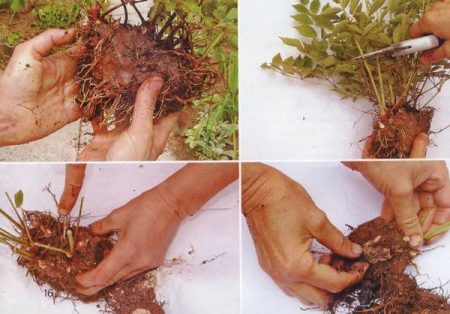
Dividing the bush.
3 way. Kidney renewal
So astilbe is propagated in early spring when the first shoots appear. To do this, you do not need to dig up the rhizome, but you just need to separate the bud and root with a sharp knife. You can take several buds from one mother bush, but no more than a third.
The cut site needs to be treated with ash and the astilbe planted for rooting in a greenhouse. The soil should be light, fertile, with a film cover on top. Here the young plants will remain until autumn or next spring.
As a rule, rooting proceeds without complications. You can plant it in open ground in autumn or early spring and soon you can expect the young bush to bloom.
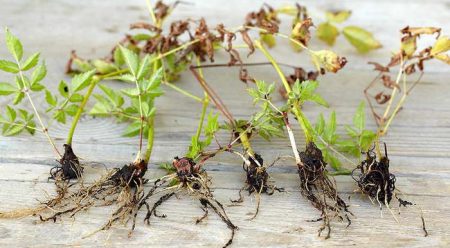
Reproduction by renewal buds
Astilbe in garden design
Astilbe is indispensable in garden design. It is always decorative:
- in the spring the first tender carved leaves unfurl,
- in summer the inflorescences open and the wind shakes the soft fluffy panicles,
- in the fall the inflorescences are replaced by no less beautiful boxes with seeds,
- after flowering ends, the curtain works for itself and becomes simply luxurious.
However, in order for it to always look well-groomed, you need to remove dead stems in a timely manner.
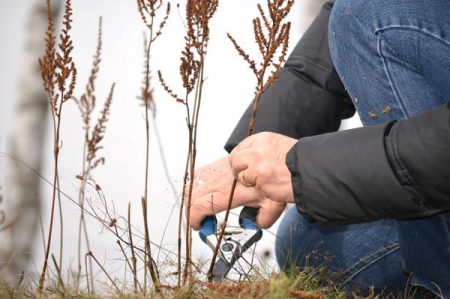
Pruning astilbe in early spring
There are many options for using astilbe in landscaping.
This flower is especially beautiful in pond design, since here is his native environment, and he has the opportunity to unfold in all his charm.
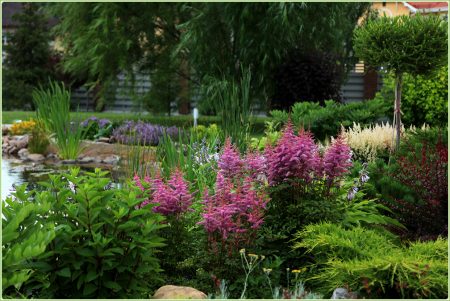
By the pond.
From tall astilbes you can make hedges and divide the site into zones.They are beautiful both in single plantings and in group plantings. The best compositions are obtained with the same beautiful plants that prefer partial shade, such as bergenia, hosta, heuchera, fern, etc.
In regions with a cool climate, it is good to plant astilbe in a flower bed along with tulips, bells, irises, etc. Our flower will feel great here on an alpine hill surrounded by saxifrages, will shave and tenacious.
Low-growing astilbes are planted in containers along with geraniums and petunia, used in outdoor flowerpots, planted next to garden figurines and made into borders.
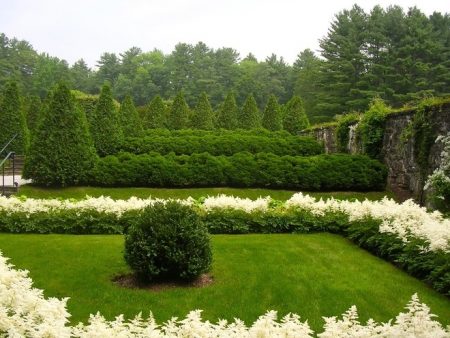
Astilbe border
The flowering period of various varieties of astilbe lasts from June to September, so you can safely create a long-blooming flowerbed only from the collection of these beautiful plants and from them collect a bouquet of dried flowers for the winter.
Diseases and pests
Astilbe is one of the few plants that almost never gets sick. Most pests are indifferent to it. But there are still some that attack this flower, for example, pennitsa.
It is also called the slobbering pennitsa, since the insect finds a secluded place in the axils of astilbe leaves, secretes foamy contents and lays larvae there. Soon the leaves begin to wrinkle, turn yellow and dry out. If measures are not taken, the plant may wither.
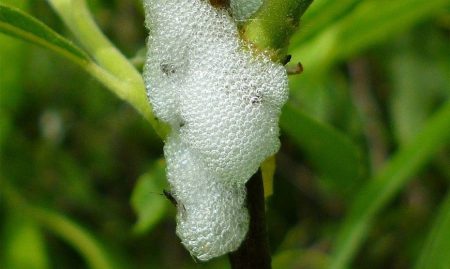
Slobbery pennies.
It is easy to spot the pennix, as its nest looks like foaming juice or a clot of saliva. If such lesions are isolated, then it is better to destroy the nests manually. If the situation gets out of control, then you need to use insecticides:
- kinmiks,
- actellik,
- akarin, etc.
Occasionally, but still, astilbe is damaged by the strawberry nematode.You can try to compete for the plant by carrying out 2 - 3 sprayings with an interval of 3 - 5 days
- mercaptophos,
- heterophos,
- phosphamtide.
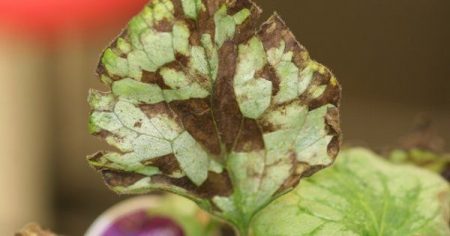
Signs of nematode damage
But most often such plants are disposed of.
Preparing for winter
Astilbes tolerate our harsh winters well. Preparation for wintering involves applying potassium fertilizers and mulching the soil around the plant. It is better not to trim the leaves. They will create additional shelter for the rhizomes. You don’t even have to remove the flower stalks if they look decorative. In winter, this will be an additional decoration for your garden and a reminder that spring will certainly come.
And with spring comes concerns about filling your site with interesting, beautiful and easy-to-care plants. Astilbe is exactly such a flower.
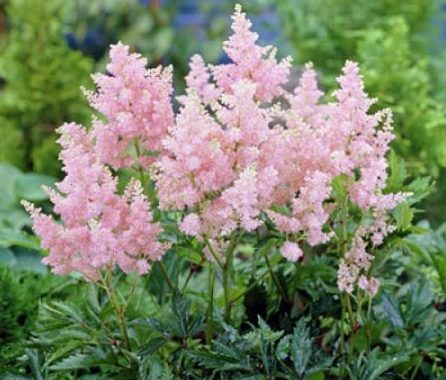
Continuation of the topic:
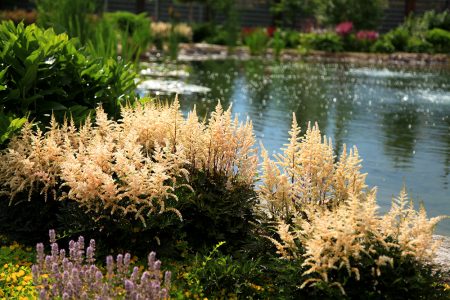
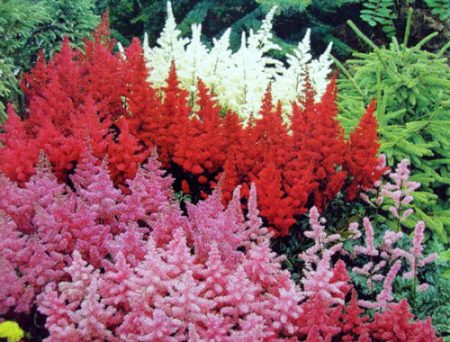
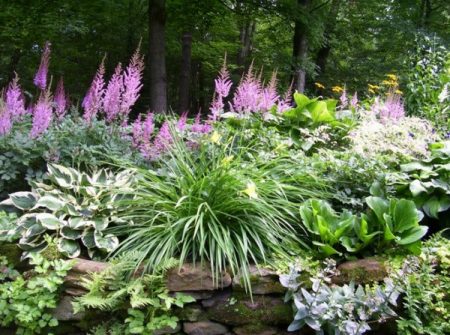
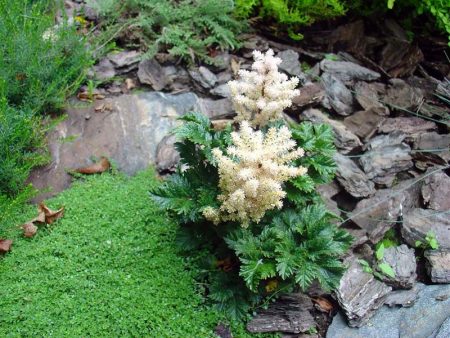

 (7 ratings, average: 4,14 out of 5)
(7 ratings, average: 4,14 out of 5) CUCUMBERS NEVER GET SICK, I'VE BEEN USING ONLY THIS FOR 40 YEARS! I SHARE A SECRET WITH YOU, CUCUMBERS ARE LIKE THE PICTURE!
CUCUMBERS NEVER GET SICK, I'VE BEEN USING ONLY THIS FOR 40 YEARS! I SHARE A SECRET WITH YOU, CUCUMBERS ARE LIKE THE PICTURE! You can dig a bucket of potatoes from each bush. Do you think these are fairy tales? Watch the video
You can dig a bucket of potatoes from each bush. Do you think these are fairy tales? Watch the video
 How our fellow gardeners work in Korea. There is a lot to learn and just fun to watch.
How our fellow gardeners work in Korea. There is a lot to learn and just fun to watch. Eye trainer. The author claims that with daily viewing, vision is restored. They don't charge money for views.
Eye trainer. The author claims that with daily viewing, vision is restored. They don't charge money for views. A 3-ingredient cake recipe in 30 minutes is better than Napoleon. Simple and very tasty.
A 3-ingredient cake recipe in 30 minutes is better than Napoleon. Simple and very tasty. Therapeutic exercises for cervical osteochondrosis. A complete set of exercises.
Therapeutic exercises for cervical osteochondrosis. A complete set of exercises. Which indoor plants match your zodiac sign?
Which indoor plants match your zodiac sign? What about them? Excursion to German dachas.
What about them? Excursion to German dachas.